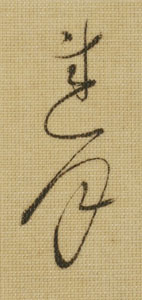Shijô
The fox spirit HakuzôsuSigned: Rengetsu
Seals:
Technique: sumi on silk 70,8 x 19,3
Mounting: light blue raw silk and olive green paper 154 x 22,3
Box: inscribed
Condition: very good
The waka reads: 人はかるさがののはらのゆうまぐれおのがお花や花とみすらん
Hito hakaru Sagano no hara no yûmagure onoga obana ya hana to misuran.
“On the field of Sugano
Where the dusk deceives us,
My tall grass plumes
Will surely look like flowers.”
(From Ama no karumo, miscellaneous poems # 40)
Konkai, the cry of the fox
An old fox who has grown tired of being hunted, disguises himself as Hakuzôsu, an elderly priest known for his love of foxes. Hakuzôsu goes to pay a visit to his nephew, a hunter, and tells him of the many virtues of foxes, but also about the evil that comes to you after illing a fox. The nephew seems convinced of the lesson, After his ‘uncle ‘has left he hears a fox cry: on his way home Hakuzôsu slowly returning to his true form, has walked into a trap.
A rare painting on silk.
Rengetsu is one of those extraordinary figures in Japanese art history, one of a kind.
Rengetsu was born in Kyoto. Within a few days after her birth the Õtagaki family adopted her. In 1798 she moved to Kameoka castle to serve the Matsudaira family. Here she studied the woman’s pursuits such as poetry and calligraphy, but she received training in martial arts as well. In 1807 she returned to her family in Kyoto where she married her adopted brother, a young samurai called Mochihisa. In the eight years of her marriage she gave birth to three children, who all died shortly after their birth. In 1815 she divorced her husband, who was to die shortly after. She remarried but already in 1823 her second husband died. She cut her hair and became a nun and took the name Rengetsu, Lotus moon.
With her daughter from her second marriage and her stepfather she moved into a small building on the grounds of the Chion-in. Two years later her daughter died. Without means of support she moved to Okazaki in the Kyoto area together with many artists, where she produced pottery and studied Shijô painting with Matsumura Keibun (1779-1843). She fell in love with Keibun and they lived together. She intensively studied waka. In spite of being a nun, men made advances to her, but not being interested, she pulled out her teeth to look less attractive and to strengthen her inner self. Her pottery became such a big success that she escaped her customers many times and moved more than thirty times, even thirteen times in one year.
She became close friends with Tessai and even tried to adopt him as a son. For the last 25 years of her life he helped and accompanied her. On the invitation of the Abbot Wada Gozan (Gesshin) (1800-1870) she spent her last years in a tea hut on the grounds of the Shinko-in temple where she deeply immersed herself in the study of Buddhism but she also continued her artistic occupations.
Reference:
Canberra 2007
Roberts p. 129
Fister '88 pp. 144-159 (# 69-76)
Price: SOLD

